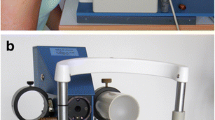Summary
The direct retinotoxic effect of antimalarial compounds can be investigated specifically on the isolated retina as shown in the preceding paper: in situ those doses of quinine or chloroquine, which delete reversibly the b-wave of the ERG, have also a determinal effect on the ECG and blood pressure. The c-wave of the ERG, however, for which so far a recording from the isolated retina of the rabbit has not yet been possible, disappears already after doses of quinine which do not yet exert a detectable action on the heart and circulation. Chloroquine, on the other hand does not show this effect on the c-wave of the cat in the acute experiment. The functional and morphological findings are confronted.
Zusammenfassung
Die retinotoxische Wirkung der Antimalariamittel kann an der isolierten Netzhaut direkt untersucht werden. Jene Chinin- bzw. Chlorochindosen, welche die b-Welle des ERG reversibel auslöschen, können auch das EKG und den Blutdruck beeinträchtigen. Die c-Welle jedoch, welche bisher von der isolierten Kaninchennetzhaut nicht abgeleitet werden konnte, wird bereits durch Chinindosen ausgelöscht, die noch keine nachweisbare Wirkung auf Herz und Kreislauf ausüben. Es kann deshalb die direkte retinotoxische Wirkung auch beim Ableiten des ERG in situ beurteilt werden. Chlorochin hingegen zeigt diese Wirkung auf die c-Welle der Katze im akuten Versuch nicht. Die funktionellen und morphologischen Befunde werden einander gegenübergestellt.
Similar content being viewed by others
Literatur
Abelsdorff, G.: Über Optochinsehstörungen und ihre anatomische Grundlage. Klin. Mbl. Augenheilk.62, 31–51 (1919).
Arden, G. B., andD. P. Greaves: The reversible alterations of the electroretinogram of the rabbit after occlusion of the retinal circulation. J. Physiol. (Lond.)133, 266–274 (1956).
Barabaschew, P.: Zur Frage der Chininamaurose (Knapp-Schweigger). Arch. Augenheilk.23, 91–96 (1891).
Bernstein, H. N., andJ. Ginsberg: The pathology of chloroquine retinopathy. Arch. Ophthal.71, 238–245 (1964).
—,N. J. Zvaifler, M. Rubin, andA. M. Mansour: The ocular deposition of chloroquine. Invest. Ophthal.2, 384–392 (1963).
Bornschein, H., O. Wichterle, andL. Wündsch: A contact lens elektrode for comparative ERG studies. Vision Res.6, 733–734 (1966).
—, u.A. Zwiauer: Das Elektroretinogramm des Kaninchens bei experimenteller Erhöhung des intraocularen Druckes. Albrecht v. Graefes Arch. Ophthal.152, 527–531 (1952).
Butler, I.: Oogafwijkingen ten gevolge van het gebruik van Chloroquine en Hydroxychlorquine. Proefschrift. “Bronder-Offset” Rotterdam 1966.
Cambiaggi, A.: Unusual ocular lesions in a case of systemic lupus erythematosus. Arch. Ophthal57, 451–453 (1957).
Hanitzsch, R., u.H. Bornschein: Spezielle Überlebensbedingungen für isolierte Netzhäute verschiedener Warmblüter. Experientia (Basel)21, 484 (1965).
Heiss, W. D., P. Heilig u.J. Hoyer: Retinale Impulsaktivität und Elektroretinogramm unter dem Einfluß von Desipramin. Experientia (Basel)23, 728–729 (1967).
Henkes, H. E.: Chlorochin-Retinopathie. Ned. T. Geneesk.109, 457–459 (1965).
Hobbs, H. E., S. P. Eadie, andF. Sommerville: Ocular lesions after treatment with chloroquine. Brit. J. Ophthal.45, 284–297 (1961).
Hommer, K.: Über die Chininvergiftung der Netzhaut. Mit einer Bemerkung zur experimentellen Chlorochinvergiftung. Klin. Mbl. Augenheilk. (Im Druck.)
—: Die Wirkung des Chinins, Chlorochins, Jodacetats und Chlordiazepoxids auf das ERG der isolierten Kaninchennetzhaut. Albrecht v. Graefes Arch. klin. exp. Ophthal.175, 111–120 (1968).
—, u.R. G. Frey: Einzelreiz- und Flimmer ERG im akuten Stadium der Chininvergiftung. Proc. Second ISCERG Symposium, Rotterdam 1963. Docum. ophthal. (Den. Haag)18, 392–403 (1964).
Jess, A.: Die Gefahren der Chemotherapie für das Auge, insbesondere über eine das Sehorgan schwer schädigende Komponente des Chinins und seiner Derivate. Albrecht v. Graefes Arch. Ophthal.104, 48–74 (1921).
Lützow, A. v.: Die Bedeutung von Plasmafaktoren für die isolierte umströmte Kaninchennetzhaut. Experientia (Basel)22, 215–216 (1966).
Meier-Ruge, W.: Medikamentöse Retinopathie. Stuttgart: Georg Thieme 1967.
Monahan, R. H., andR. C. Horns: The pathology of chloroquine in the eye. Trans. Acad. Amer. Ophthal. Otolaryng.68, 40–44 (1964).
Noell, W. K.: Azide-sensitive potential difference across the eye-bulb. Amer. J. Physiol.170, 217–238 (1952).
—: The origin of the electroretinogram. Amer. J. Ophthal.38, 78–93 (1954).
Okun, E., P. Gouras, H. Bernstein, andL. v. Sallmann: Chloroquine retinopathy. Arch. Ophthal.69, 59–71 (1963).
Potts, A. M.: Further studies concerning the accumulation of polycyclic compounds on uveal melanin. Invest. Ophthal.3, 399–404 (1964).
Schulze, J., u.G. Jünemann: Elektroretinografischer Beitrag zur Frage der Chinin-Amblyopie. 113. Verslg. d. Vereines Rhein-Westf. Augenärzte 1966.
Sickel, W., H. G. Lippmann, W. Haschke u.Ch. Baumann: Elektrogramm der umströmten menschlichen Retina. Dtsch. ophthal. Ges.63, 316–318 (1961).
Uhthoff, W.: Die Augenstörungen bei Vergiftungen,Graefe-Saemisch Handbuch der gesamten Augenheilkunde, 2. Aufl., Bd. 11, Abt. 2 A, S. 75–86. Leipzig: Wilhelm Engelmann 1911.
Wetterholm, D. H., andF. C. Winter: Histopathology of Chloroquine retinal toxicity. Arch. Ophthal.71, 82–87 (1964).
Wunderlich, G.: Die Chininintoxikation und ihre Pathogenese mit Bericht über eine eigene Beobachtung. Klin. Mbl. Augenheilk.64, 270–286 (1920).
Zvaifler, N. J., H. N. Bernstein, andM. Rubin: Chloroquine deposition in ocular tissues. Arthr. and Rheum.5, 667 (1962).
Author information
Authors and Affiliations
Rights and permissions
About this article
Cite this article
Hommer, K., Ulrich, W.D. & Wündsch, L. Direkte und indirekte Beeinflussung des ERG durch Antimalariamittel. Albrecht von Graefes Arch. Klin. Ophthalmol. 175, 121–130 (1968). https://doi.org/10.1007/BF02385057
Received:
Issue Date:
DOI: https://doi.org/10.1007/BF02385057




